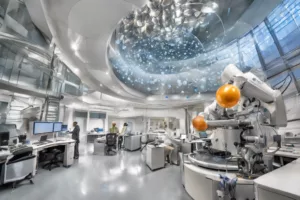
Researchers from UT Southwestern and UT Dallas discover a novel approach to deliver chemotherapy drugs across the blood-brain barrier, offering hope for more effective treatments for glioblastoma.
Glioblastoma, the most common and aggressive primary brain tumor, has long posed a significant challenge for medical researchers. The blood-brain barrier (BBB), a protective mechanism that prevents the entry of potentially toxic substances into the brain, has made it difficult to effectively deliver chemotherapy drugs to glioblastoma cells. However, a recent study led by researchers from UT Southwestern Medical Center and UT Dallas has shown promising results by combining designer nanoparticles with chemotherapy drugs. This breakthrough approach has the potential to revolutionize glioblastoma treatment and improve patient outcomes.
Breaking Down the Barrier: OptoBBTB
For decades, researchers have been searching for ways to breach the BBB and deliver chemotherapy drugs directly to glioblastoma cells. Previous methods have had limited success due to the risks of toxicity and heat damage. In this study, the research team developed a new strategy called optoBBTB. They coated gold nanoparticles with antibodies that target a key protein in the BBB complex. When these nanoparticles are injected into animal models and stimulated with a specific wavelength of laser light, they vibrate and open the BBB without generating heat.
Successful Breach of the BBB
Using genetically engineered mice that mimic key features of human glioblastoma, the researchers demonstrated that optoBBTB successfully breached the BBB. After injecting the nanoparticles and administering the chemotherapy drug paclitaxel, the drug readily infiltrated the animals' tumors. The researchers observed significant tumor shrinkage and a 50% increase in the survival rate of the mouse models compared to those receiving standard intravenous treatment or a placebo.
Expanding Treatment Options
While the survival gains achieved with optoBBTB are remarkable, the true potential lies in its ability to allow a wide range of promising chemotherapy drugs to cross the BBB. Currently, 98% of these drugs are unable to penetrate the barrier. By utilizing this innovative approach, researchers hope to unlock new possibilities for treating glioblastoma and improving patient outcomes.
Implications for Glioblastoma Treatment
Glioblastoma has long been associated with a grim prognosis, with a median survival rate of just 15 months after diagnosis. The inability to effectively deliver chemotherapy drugs to the tumor has been a major hurdle in improving treatment outcomes. The findings from this study offer a glimmer of hope for patients battling this aggressive brain tumor. By combining designer nanoparticles with chemotherapy drugs, researchers have demonstrated a potential game-changer in the fight against glioblastoma.
The groundbreaking research conducted by the team at UT Southwestern and UT Dallas has shed light on a new approach to treating glioblastoma. By utilizing designer nanoparticles and laser stimulation, they have successfully breached the blood-brain barrier and delivered chemotherapy drugs directly to the tumor. This breakthrough offers hope for more effective treatments and improved survival rates for glioblastoma patients. As further research and clinical trials are conducted, this innovative approach has the potential to transform the landscape of glioblastoma treatment and provide a ray of hope for those affected by this devastating disease.

George Smith, with over a decade in tech journalism, excels in breaking down emerging tech trends. His work, spanning tech blogs and print, combines in-depth analysis with clarity, appealing to a wide readership. George's pieces often explore technology's societal impact, showcasing his foresight in industry trends.







